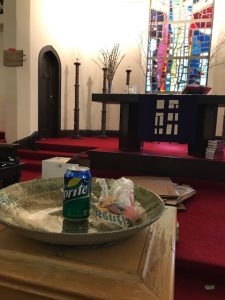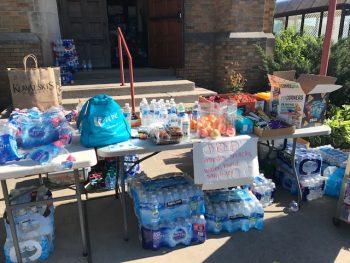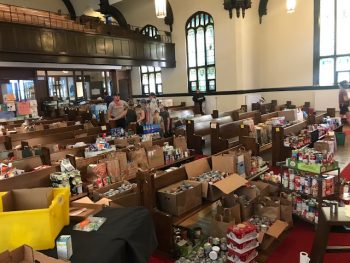 By Emilie Bouvier
By Emilie Bouvier
A photo in my phone from five weeks ago shows an empty can of Sprite and a wrapper sitting in the baptismal font at the front of the sanctuary at Holy Trinity. Just outside the frame are pews stacked full of canned goods, diapers, and baby formula. I have to tell you: In this moment of reckoning and resistance, my understandings of sacrament and liturgy have shifted.
The waters in that font and sanctuary were not static. They were not confined to a placid pool, but rather were waters in motion – water carried in plastic bottles and, yes, even in cans of Sprite – flowing forth to meet the thirst of neighbors still reeling from the trauma.
“De-centering ourselves in our building use is now happening in real time in more tangible ways than we could have imagined.”
My own congregation, Calvary Lutheran, looks similar. As I open up the church to set up the community table, I walk through the Narthex where I’d usually be hanging out for coffee hour – sharing treats and conversation after worship.
Now it’s a back-stocked staging area as we offer snacks and cold drinks outside the front steps to folks going to and from the George Floyd memorial site one block away. Emergency supplies of diapers, soaps, and personal care products are stacked alongside granola bars, Flamin’ Hot Cheetos, and Gatorade.
I’D BE LYING IF I said the Sundays I’ve come to host the community table right after our weekly Zoom worship haven’t been the sacramental-feeling coffee hour I’ve normally experienced at Calvary. We’ve intentionally talked as a congregation about what it would look like to have the doors more widely open.
We were already looking for ways to de-center ourselves and do better to foster connection with our wider neighborhood and community in how we gather. Now it is happening in real time in more tangible ways than we could have imagined.
 But it’s not just about naming Christ present with us as we “break bread” with our neighbors in different ways. It’s not just substituting Luna bars and fruit juice on the sidewalk for coffee cake and lemonade in the Narthex.
But it’s not just about naming Christ present with us as we “break bread” with our neighbors in different ways. It’s not just substituting Luna bars and fruit juice on the sidewalk for coffee cake and lemonade in the Narthex.
We also have to be willing to name that Christ’s body broken mirrors the broken bodies of George Floyd, Philando Castile, and Jamar Clark; of Ahmaud Arbery and Breonna Taylor; of Eric Garner and Trayvon Martin. We recognize that Jesus’ death under the rule of an oppressive empire brings the realities of empire and injustice into focus, and reminds us that our God is a God of justice and transformation. We see anew that the work of collective liberation is God’s work – work in which we are called to participate.
“The waters in and around that font were not confined to a placid pool, but were waters in motion – water carried in plastic bottles – flowing forth to meet the thirst of neighbors still reeling from the trauma.”
As with good liturgy, I often find that my body learns the movements, and then my theology catches up. I take a knee and pray long with neighbors, strangers, and a speaker at a mic in front of the George Floyd memorial. I chant. I raise my fist. I join fellow church members and friends old and new as we carry loads of bottled water and bags of laundry soap into the church. These bodily motions become a liturgy that shape me. 
We are all invited to find ways to learn and experience these moments and movements in our bodies too. And then may we intentionally let our theology catch up.

